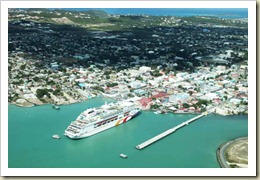St John’s
 The capital of the nation of Antigua and Barbuda is St. John’s, the country’s largest city. Its population reached in 2000 a number of 24226 inhabitants. The capital is also the country’s commercial center and the main port of Antigua island.
The capital of the nation of Antigua and Barbuda is St. John’s, the country’s largest city. Its population reached in 2000 a number of 24226 inhabitants. The capital is also the country’s commercial center and the main port of Antigua island.
St. John’s has got an administrative role since 1632, when it was first colonized. The Government established its seat here in 1981, when the country gained its independence.
Economy
St. John is very cosmopolite and well developed. It has numerous shopping malls and boutiques with designer clothing and jewelry. Along the international brands, there are also many local, independent establishments offering different fashions.
American and European tourists come here from cruise ships that dock at Redcliffe Quay and Heritage Quay a couple of times per week. Also tourists from the island’s resorts come for shopping in St. John. Besides the shopping industry, the city is also a hot spot for the banking industry.
If you want some fresh products for your dinner, go to the city’s southwestern edge where there is a market of fresh meats and fish. The island’s single rum distillery is at the Citadel and it produces over 180 000 gallons each year.
Demographics
The population of the capital is mostly the same as in the rest of the island, a mix of populations arrived and established here: Africans, European-Africans and Levantine Christian Arabs.
Culture
There are museums to visit in St. John’s: the Marine Art Museum and the Antigua and Barbuda Museum. In the Marine Art Museum you can admire a variety of volcanic stones, fossilized bedrock, over 10 000 shells, petrified wood and some artifacts from English shipwrecks.
There is also a Stadium, east of the city, called Sir Vivian Richards. The Stadium was initially created for cricket matches, but it is now a multi-use facility.